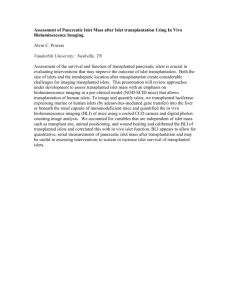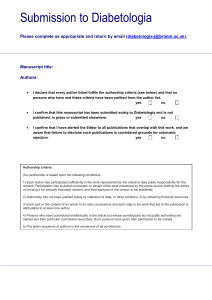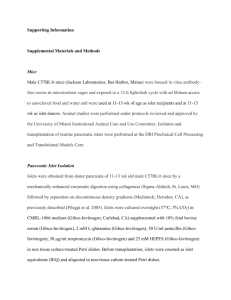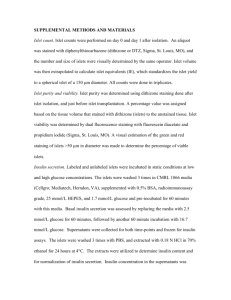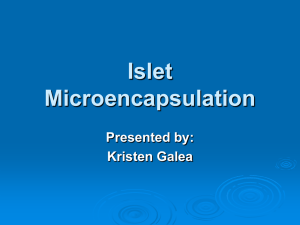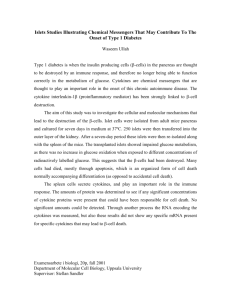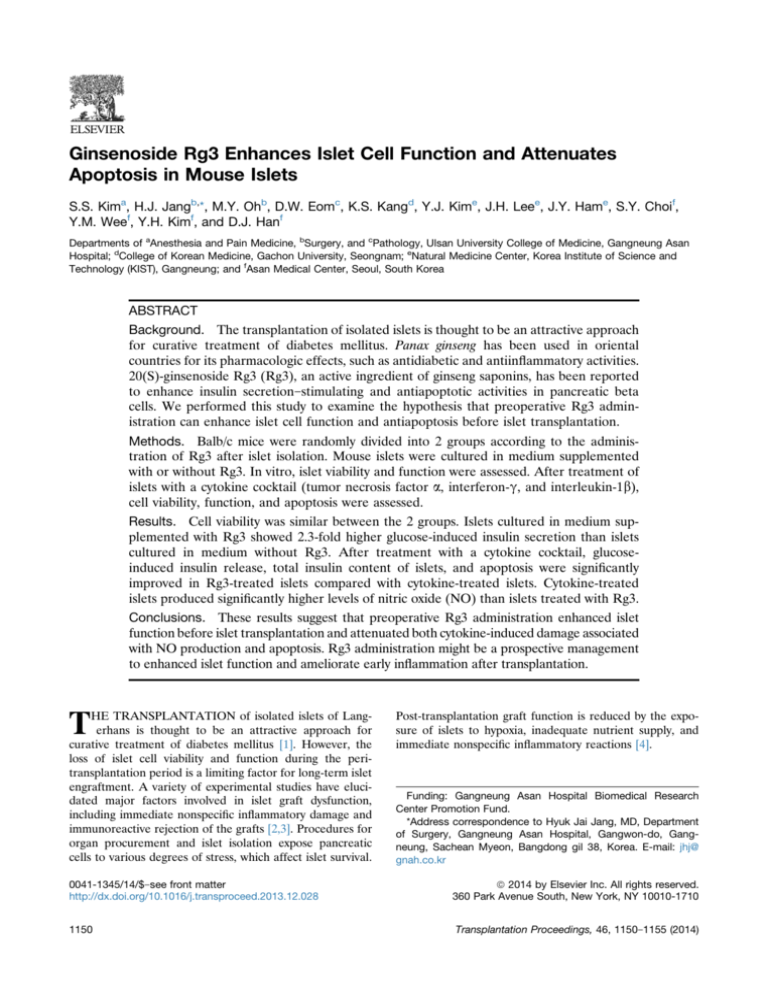
Ginsenoside Rg3 Enhances Islet Cell Function and Attenuates
Apoptosis in Mouse Islets
S.S. Kima, H.J. Jangb,*, M.Y. Ohb, D.W. Eomc, K.S. Kangd, Y.J. Kime, J.H. Leee, J.Y. Hame, S.Y. Choif,
Y.M. Weef, Y.H. Kimf, and D.J. Hanf
Departments of aAnesthesia and Pain Medicine, bSurgery, and cPathology, Ulsan University College of Medicine, Gangneung Asan
Hospital; dCollege of Korean Medicine, Gachon University, Seongnam; eNatural Medicine Center, Korea Institute of Science and
Technology (KIST), Gangneung; and fAsan Medical Center, Seoul, South Korea
ABSTRACT
Background. The transplantation of isolated islets is thought to be an attractive approach
for curative treatment of diabetes mellitus. Panax ginseng has been used in oriental
countries for its pharmacologic effects, such as antidiabetic and antiinflammatory activities.
20(S)-ginsenoside Rg3 (Rg3), an active ingredient of ginseng saponins, has been reported
to enhance insulin secretionestimulating and antiapoptotic activities in pancreatic beta
cells. We performed this study to examine the hypothesis that preoperative Rg3 administration can enhance islet cell function and antiapoptosis before islet transplantation.
Methods. Balb/c mice were randomly divided into 2 groups according to the administration of Rg3 after islet isolation. Mouse islets were cultured in medium supplemented
with or without Rg3. In vitro, islet viability and function were assessed. After treatment of
islets with a cytokine cocktail (tumor necrosis factor a, interferon-g, and interleukin-1b),
cell viability, function, and apoptosis were assessed.
Results. Cell viability was similar between the 2 groups. Islets cultured in medium supplemented with Rg3 showed 2.3-fold higher glucose-induced insulin secretion than islets
cultured in medium without Rg3. After treatment with a cytokine cocktail, glucoseinduced insulin release, total insulin content of islets, and apoptosis were significantly
improved in Rg3-treated islets compared with cytokine-treated islets. Cytokine-treated
islets produced significantly higher levels of nitric oxide (NO) than islets treated with Rg3.
Conclusions. These results suggest that preoperative Rg3 administration enhanced islet
function before islet transplantation and attenuated both cytokine-induced damage associated
with NO production and apoptosis. Rg3 administration might be a prospective management
to enhanced islet function and ameliorate early inflammation after transplantation.
T
HE TRANSPLANTATION of isolated islets of Langerhans is thought to be an attractive approach for
curative treatment of diabetes mellitus [1]. However, the
loss of islet cell viability and function during the peritransplantation period is a limiting factor for long-term islet
engraftment. A variety of experimental studies have elucidated major factors involved in islet graft dysfunction,
including immediate nonspecific inflammatory damage and
immunoreactive rejection of the grafts [2,3]. Procedures for
organ procurement and islet isolation expose pancreatic
cells to various degrees of stress, which affect islet survival.
Post-transplantation graft function is reduced by the exposure of islets to hypoxia, inadequate nutrient supply, and
immediate nonspecific inflammatory reactions [4].
Funding: Gangneung Asan Hospital Biomedical Research
Center Promotion Fund.
*Address correspondence to Hyuk Jai Jang, MD, Department
of Surgery, Gangneung Asan Hospital, Gangwon-do, Gangneung, Sachean Myeon, Bangdong gil 38, Korea. E-mail: jhj@
gnah.co.kr
0041-1345/14/$esee front matter
http://dx.doi.org/10.1016/j.transproceed.2013.12.028
ª 2014 by Elsevier Inc. All rights reserved.
360 Park Avenue South, New York, NY 10010-1710
1150
Transplantation Proceedings, 46, 1150e1155 (2014)
GINSENOSIDE RG3 ENHANCES ISLET CELL FUNCTION
Panax ginseng has been used widely in oriental countries
for its pharmacologic effects, such as antidiabetic, antiinflammatory, antioxidant, and antiapoptotic activities.
Ginseng has been used as an antidiabetic herb for several
thousand years in Asia, with ginsenosides as important
active ingredients. The mitochondrial protein-uncoupling
protein 2 (UCP-2) has been found to play a critical role in
insulin synthesis and pancreatic beta-cell survival. Ginseng
inhibits UCP-2 expression, which may contribute to the
ability of ginseng to both protect beta cells from death and
improve insulin synthesis [5].
20(S)-Ginsenoside Rg3 (Rg3) is an active ingredient of
ginseng saponins, and has been reported to enhance pancreatic
beta-cell insulin secretion and antiapoptotic activities. Rg3
lowered plasma glucose levels by stimulating insulin secretion,
an action associated with adenosine triphosphateesensitive Kþ
channels, and protected MIN6N8 cells (pancreatic beta cells)
against palmitate-induced apoptosis [6,7].
Rg3 administration has not been applied to islet transplantation. Therefore, we performed the present mouse
study to examine the hypothesis that preoperative Rg3
administration both enhances pre-transplantation islet cell
function and antiapoptosis before islet transplantation and
attenuates cytokine-induced damage in islets.
METHODS
Animals
Female Balb/c mice (12 weeks of age) were purchased from JeungDo Bio Plant Co (Seoul, Korea). Our study was reviewed and
approved by the Animal Care and Use Committee of Korea Institute of Science and Technology (Gangneung, Korea).
20(S)-Ginsenoside Rg3 (Rg3)
Rg3 was purchased from Ambo Institute (South Korea), and dissolved in 0.1% dimethyl sulfoxide (DMSO). The chemical structure
of Rg3 is shown in Fig 1.
1151
Mouse Islet Isolation
Islets were isolated from Balb/c mice pancreas by a collagenase
digestion procedure. After isolation, islets were cultured in RPMI1640 medium supplemented with 10% fetal bovine serum (FBS)
overnight in an atmosphere of 95% air and 7% CO2 at 37 C.
Treatment with Rg3 and Cytokine Cocktail
Pancreatic islets were isolated from Balb/c mice. After isolation, the
islets were randomly divided into 2 groups, one for control and one
for administration of Rg3. Mouse islets were cultured in medium
supplemented with or without Rg3 (4 mmol/L) for 24, 48, and 72
hours, after which islet viability and function were assessed in vitro.
Isolated islets from mice were exposed to a cytokine cocktail (10 ng/mL
interleukin [IL]-1b, 25 ng/mL tumor necrosis factor (TNF) a,
and 50 ng/mL interferon [IFN] g; R&D Systems, Minneapolis,
Minnesota) and then assayed in vitro to assess cell viability,
function, and apoptosis.
Islet Cell Viability
Islet viability was assessed by fluorescent staining with diacetatepropidium iodide.
Islet Cell Function
Islet function was performed by static glucose incubation and
expressed as a stimulation index (SI), calculated by dividing the
insulin secretion of islets challenged with high glucose concentration (16.7 mmol/L) by the insulin secretion under low glucose
conditions (1.6 mmol/L). Secreted insulin level was measured with
the use of a mouse insulin enzyme-linked immunsorbent assay
(ELISA) kit (Alpco, Salem, New Hampshire).
Islet Insulin and DNA Content
Islets were washed with phosphate-buffered saline solution and
extracted with HCl (0.18 mol/L) in 75% ethanol for 18 hours at 4 C.
The acid-ethanol extracts were collected for determination of insulin content. Insulin was determined with the use of a mouse insulin ELISA kit (Alpco). The islet DNA content was quantified with
the use of Pico reen kit (Molecular Probes, Eugene, Oregon) according to the manufacturer’s instruction.
Insulin Immunostaining
Immunostaining for monoclonal antiinsulin antibody (1:4,000 dilution; Sigma-Aldrich, St Louis, Missouri) and hematoxylin and eosin
staining were performed on the cell blocks of the cultured islets (300
islets). Immunohistochemical staining was performed in the BondMax automatic immunostaining device (Leica Biosystem, Newcastle, United Kingdom) with the use of a bond polymer intensity
detection kit (Leica Biosystem) for ethanol-fixed paraffin-embedded
tissue sections. Four-micrometer-thick sections were obtained by
microtome, transferred onto adhesive slides, and dried at 62 C for 30
minutes. Slides were counterstained with Harris hematoxylin. As
positive control samples, we used normal pancreatic tissue. Negative
control was provided by omitting the primary antibodies.
Islet Cell Apoptosis Assay
Fig 1. Chemical structure of ginsenosides Rg3.
After islet culture and treatment, evaluation of cell death was
performed with the use of a programmed cell death detection
ELISA-plus kit (Roche, Burgess Hill, United Kingdom), according
to the manufacturer’s instructions. Absorbance was measured at
405 nm against 2,20 -azino-bis(3-ethylbenzothiazoline-6-sulphonic
1152
acid) (ABTS) solution and ABTS stop solution as a blank with the
use of a Novostar plate reader (BMG Labtech, Aylesbury, United
Kingdom), and the results expressed in arbitrary units of
oligonucleosome-associated histone.
Western Blotting Analysis
Polyclonal antibodies against cleaved and poly(ADP-ribose) polymerase (PARP), inducible nitrate synthase (iNOS) and glyceraldehyde 3-phosphate dehydrogenase (GAPHD) were purchased
from Cell Signaling Technology (Danvers, Massachusetts). Other
chemicals and reagents were of high quality and obtained from
commercial sources. Mouse islet cells (400 islets) were grown in
60-mm dishes and treated with the indicated concentration of
compounds for 24 hours. Whole-cell extracts were then prepared
according to the manufacturer’s instructions with the use of RIPA
buffer (Cell Signaling) supplemented with 1 protease inhibitor
cocktail and 1 mmol/L phenylmethylsulfonyl fluoride. Proteins
(whole-cell extracts, 30 mg/lane) were separated by electrophoresis
in a precast 4%e15% Mini-Protean TGX gel (Bio-Rad, California),
blotted onto polyvinylidene fluoride transfer membranes, and
analyzed with epitope-specific primary and secondary antibodies.
Bound antibodies were visualized with the use of ECL Advance
Western Blotting Detection Reagents (GE Healthcare, United
Kingdom) and an LAS 4000 imaging system (Fujifilm, Japan).
KIM, JANG, OH ET AL
Nitrite Formation
Islets isolated from mice were cultured with a cytokine cocktail and
accumulated nitrite production was measured. Nitrite formation
was measured with the use of Griess reagent. Nitrite was detected in
the cultures by mixing 100 mL supernate with 100 mL Griess reagent.
Absorbances were read at 540 nm, and nitrite concentrations were
calculated with the use of a sodium nitrite standard curve.
Statistical Analysis
Results are expressed as mean standard error of the mean
(SEM). Statistical analysis used the independent Student t test and
the analysis of variance test with the use of SPSS software. A P
value of .05 was regarded to be statistically significant.
RESULTS
Islet cell viability was assessed by diacetateepropidium iodide staining at 24, 48, and 72 hours after the isolation
procedure. Viability values for the Rg3 groups were similar
to those of the control groups at 24, 48, and 72 hours and
showed no statistical difference between the 2 groups
(Fig 2A). Rg3 suppressed the cleavage of PARP. PARP
(116 kDa) is cleaved to produce an 89-kDa fragment during
Fig 2. (A) Islet cell viability and function assessed at 24, 48, and 72 hours after the isolation procedure. Cells were treated in the presence or absence of 4 mmol/L Rg3 for 24, 48, and 72 h. Cell viability was determined by the diacetateepropidium iodide assay. Values are
presented as mean SEM (n ¼ 3). Means among groups were not significantly different (P > .05). (B) Islets that were cultured in medium supplemented with Rg3 showed higher glucose-induced insulin secretion than islets cultured for 24 h and 48 h in unsupplemented
medium (P < .05). *P < .05 compared with the control group. (C) Effect of ginsenoside Rg3 on the induced cleavage of PARP in mouse
islet cells. Cells were incubated in the presence or absence of Rg3 (4 mmol/L) for 48 hours and 72 hours. Cell lysates were subjected to
Western blot analysis for cleaved poly (ADP-ribose) polymerase (PARP) and GAPDH. The density ratios ofcleaved PARP/GAPDH
differed significantly among the groups (P < .05). *P < .05 compared with the corresponding value of the control group.
GINSENOSIDE RG3 ENHANCES ISLET CELL FUNCTION
apoptosis. PARP cleavage, as evidenced by the accumulation of the 89-kDa species, was observed when mouse islet
cells were incubated with 4 mmol/L Rg3 for 48 hours and 72
hours. The activation of PARP was significantly recovered
by treatment with Rg3 at 4 mmol/L (Fig 2B). Islets cultured
in medium supplemented with Rg3 showed 2.3- to 1.5-fold
higher glucose-induced insulin secretion than islets
cultured for 24 hours and 48 hours in unsupplemented
medium (Fig 2C).
After cytokine cocktail (TNF-a, IFN-g, and IL-1b)
treatment, islet function was significantly improved in
Rg3-treated cells compared with islets treated only with
cytokines (P < .05). Islets treated with Rg3 exhibited a
strong insulin immunostaining of islets compared with
islets treated with cytokines (Fig 3A). Islets treated with
Rg3 showed a 2.2-fold higher total insulin content of islets and an enhanced 1.7-fold higher glucose-induced insulin release compared with islets treated with cytokines
(Fig 3B and C).
1153
Islets treated with Rg3 exhibited an improved viability
and an attenuated apoptosis in response to cytokines (Fig
4A and B). Islets treated with cytokines produced significantly higher levels of nitric oxide (NO) than islets treated
with Rg3 (P ¼ .05). The Rg3-treated group demonstrated
attenuated cytokineeinduced iNOS and NO production (Fig
4C and D).
DISCUSSION
This study indicates that mouse islet function (glucosestimulated insulin secretion) can be increased by simple Rg3
culturing methods after the isolation procedure. In addition,
we observed lower apoptotic levels in islets isolated from
Rg3-cultured groups, indicating less inflammatory damage.
Islet transplantation is a promising treatment of diabetes
mellitus [1]. However, it faces several challenges, including
the loss of islet cell viability and function during the peritransplantation period, which is one of the limiting factors
Fig 3. Insulin immunonostaining, insulin secretion, and total insulin content of islets in response to cytokines. (A) Islets that were
cultured in medium supplemented with Rg3 showed stronger insulin immunostaining than islets cultured for 24 hours in unsupplemented medium in response to a cytokine cocktail (CTK; 10 ng/mL interleukin-1b, 25 ng/mL tumor necrosis factor a, and 50 ng/mL
interferon-g; hematoxylin and eosin (HE) stain, insulin stain, 400). (B) Islet function was assessed by static incubation after 24 hours.
Islets treated with Rg3 exhibited an enhanced glucose-induced insulin release in response to CTK (P < .05). Results shown are mean SEM of 3 representative independent mouse islet preparations. *P < .05 compared with CTK. (C) Total insulin content of islet was
assessed by static incubation after 24 hours. Islets treated with Rg3 exhibited an enhanced total insulin content of islet in response
to CTK (P < .05). Results shown are mean SEM of 3 representative independent mouse islet preparations. *P < .05 compared
with CTK.
1154
KIM, JANG, OH ET AL
Fig 4. Islet cell viability and apoptosis in response to cytokines. (A) Isolated islets were cultured for 24 hours in the absence or presence of cytokine cocktail (CTK). The islets were then stained with propidium iodide and diacetate stain, and necrotic cells were counted.
The increased level was significantly reduced by the addition of Rg3 for 24 hours (P < .05). Graphical representations show mean SEM. *P < .05 compared with CTK. (B) Cell death detection and apoptosis assay were performed with a programmed cell death detection enzyme-linked immunosorbent assay kit. The increased level was significantly reduced by the addition of Rg3 for 48 hours (P <
.05). Graphical representations show mean SEM. *P < .05 compared with CTK. (C) Nitrite formation in the incubation media from
200 islets incubated for 48 hours with or without CTK was determined. Rg3-treated islets showed attenuated CTK-induced nitric oxide
production (P ¼ .05). Bars show mean SEM for 3 independent experiments. *P < .05 compared with corresponding CTK. (D) Effect of
Rg3 on the inducible nitrate synthase (iNOS) in mouse islet cells. Cells were incubated in the presence or absence of Rg3 (4 mmol/L) for
24 hours. Cell lysates were subjected to Western blot analysis for iNOS and GAPDH. The density ratios of iNOS/GAPDH differed significantly among the groups (P < .05). *P < .05 compared with the corresponding value of the CTK group.
for long-term islet engraftment. In current clinical practice,
islets are transplanted into the liver, and patients must
receive islets obtained from 2 or 3 donors to normalize
blood glucose levels. Transplantation between 1 donor and
1 recipient is not sufficient, because a large quantity of islets
are destroyed soon after islet transplantation, leaving <30%
of islets surviving and functioning [8].
Ginseng, referring to the roots of Panax ginseng, has been
widely used in traditional oriental medicine for its wide
spectrum of medicinal effects, such as antiinflammatory,
antitumorigenic, adaptogenic, and antiaging activities, and it
has antidiabetic, antioxidant, and antiapoptotic activities.
The mitochondrial protein UCP-2 plays a critical role in
insulin synthesis and pancreatic beta-cell survival. Ginseng
inhibits UCP-2 expression, which may contribute to the
ability of ginseng to both protect beta cells from death and
improve insulin synthesis. Ginseng was found to suppress
UCP-2, down-regulate caspase-9, increase adenosine
triphosphate (ATP) and insulin production/secretion, and
up-regulate Bcl-2 to reduce apoptosis. The ginseng effect of
decreasing apoptosis might occur via the inhibition of
mitochondrial UCP-2, which leads to an increase in the
levels of ATP and the antiapoptotic factor Bcl-2 while
down-regulating the proapoptotic factor caspase-9. These
findings suggest that ginseng stimulates insulin production
and protects from beta-cell loss [5].
Many of its medicinal effects are attributed to the triterpene glycosides known as ginsenosides. Ginsenoside Rg3
is one of the active ingredients of ginseng saponins. Rg3 had
been reported to enhance the insulin secretion and antiapoptotic activities of pancreatic beta cells [6,7]. Rg3 was
found to lower plasma glucose levels by stimulating insulin
GINSENOSIDE RG3 ENHANCES ISLET CELL FUNCTION
secretion, and this action was associated with ATP-sensitive
Kþ channels. Rg3 treatment also enhanced glucosestimulated insulin secretion and markedly phosphorylated
adenosine monophosphateeactivated protein kinase [6]. In
the present study, we showed that Rg3 treatment of mouse
islets enhanced glucose-stimulated insulin release and total
insulin content of islets under normal conditions and after
treatment with cytokines.
Rg3 was found to protect MIN6N8 pancreatic beta cells
against palmitate-induced apoptosis, in part by suppressing
PARP cleavage and activating p44/42 [7]. PARP is a DNA
repair enzyme that can be activated by DNA strand breaks.
The cleavage of full-length PARP (116 kDa) to cleaved
PARP (89 kDa) serves as a marker of cell apoptosis [9]. Our
study indicates that Rg3 treatment blocked the cleavage of
PARP caused by isolated mouse islet cells. Our results
suggest that the antiapoptotic effect of Rg3 involves the
suppression of PARP cleavage.
Cytokine-induced inhibition of insulin secretion and islet
destruction is characterized by the expression of iNOS in
b-cells, followed by NO-mediated inhibition of islet
oxidative metabolism [4]. Islets exposed to Rg3 appear to
be resistant to cellular death induced by NO donor compounds. In the present study, we showed that Rg3
enhanced glucose-stimulated insulin release and prevented
cell death and NO production by mouse islets. These results suggest that preoperative Rg3 administration before
islet transplantation attenuates cytokine-induced islet cell
damage.
We suggest that Rg3 increases islet cell function and bcell mass by protecting islets from cytokine-induced injury
which ultimately leads to apoptosis and cell death. This
finding correlates with earlier studies that observed a
reduction in apoptotic cell death in pancreatic islets in the
presence of Rg3 [5e7]. In support of those findings, our
1155
study found small amounts of apoptotic proteins in the Rg3treated islets compared with the control islets.
Our results suggest that Rg3 administration before islet
transplantation enhances islet cell function and attenuates
cytokine-induced injury associated with NO production and
apoptosis. These findings might lead to effective management of early inflammation and damage to islet cells after
islet transplantation.
REFERENCES
[1] Shapiro AM, Lakey JR, Ryan EA, et al. Islet transplantation
in seven patients with type 1 diabetes mellitus using a
glucocorticoid-free immunosuppressive regimen. N Engl J Med
2000;343:230e8.
[2] Berney T, Ricordi C. Islet cell transplantation: the future?
Langenbecks Arch Surg 2000;385:373e8.
[3] Vajkoczy P, Olofsson AM, Lehr HA, et al. Histogenesis and
ultrastructure of pancreatic islet graft microvasculature: evidence
for graft revascularization by endothelial cells of host origin. Am J
Pathol 1995;146:1397e405.
[4] Scarim AM, Heitmeier MR, Corbett JA. Heat shock inhibits
cytokine-induced nitric oxide synthase expression by rat and human
islets. Endocrinology 1998;139:5050e7.
[5] Luo JZ, Luo L. American ginseng stimulates insulin production and prevents apoptosis through regulation of uncoupling
protein-2 in cultured beta cells. Evid Based Complement Alternat
Med 2006;3:365e72.
[6] Park MW, Ha J, Chung SH. 20(S)-Ginsenoside Rg3 enhances
glucose-stimulated insulin secretion and activates AMPK. Biol
Pharm Bull 2008;31:748e51.
[7] Kim K, Park M, Kim HY. Ginsenoside Rg3 suppresses
palmitate-induced apoptosis in MIN6N8 pancreatic beta-cells.
J Clin Biochem Nutr 2010;46:30e5.
[8] van der Windt DJ, Bottino R, Casu A, et al. Rapid loss of
intraportally transplanted islets: an overview of pathophysiology
and preventive strategies. Xenotransplantation 2007;14:288e97.
[9] Schreiber V, Dantzer F, Ame JC, et al. Poly(ADP-ribose):
novel functions for an old molecule. Nat Rev Mol Cell Biol 2006;7:
517e28.

